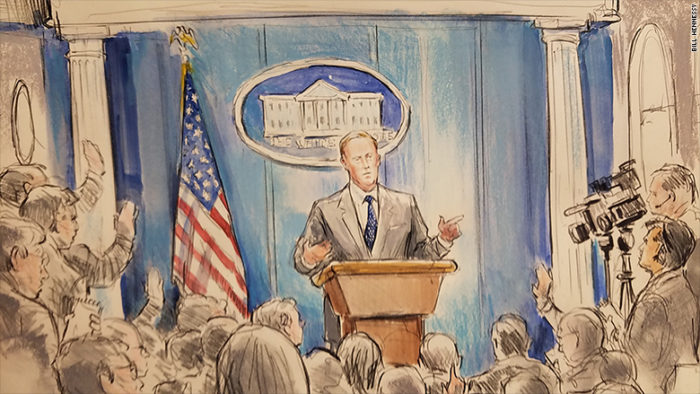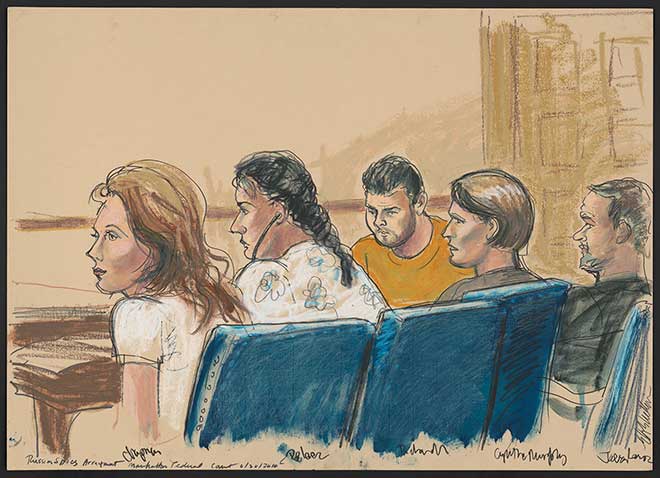When recording bans leave the public in the dark, illustrators shed light

On June 24, 2017, the communications team of the White House banned the use of cameras in the press briefing. CNN reacted to this by sending courtroom artist Bill Hennessy to attend the press briefing, where he created a sketch of the scene that you see above.
Hennessy’s sketch shows Sean Spicer standing behind the podium and next to a giant U.S. flag. His finger is pointed towards the next reporter he’s going to take the question from in the packed briefing room. One person with a video equipment stands to the side, his camera pointed downwards. While the illustration may not give us details on the conversation that was held, it still speaks a thousand words.
Bill Hennessy was the right person for the assignment. He illustrates the proceedings at the United State’s Supreme Court, which has kept limits on reporters recording video in place well in the 21st century. These White House restrictions on the press and limitations are part of a larger pattern of threats to open government by the Trump administration, but to what extent can an illustration give us insights about what is happening inside the government beyond a livestream on YouTube?
Illustrations have been used to poignantly record the experiences of civilians and politicians in places where no other means for documentation exist. Their popularity stem from the fact that they can be used to summarize an entire event or a series of events in one image. The illustration in which Thomas Jefferson signs the Declaration of Independence in 1776 is a landmark sketch that gives public a glimpse of conditions under which it was signed.

The history of illustrated court proceedings and press briefings in democracies goes back centuries. Cartoons, sketches and more formal art have been a powerful way of getting a peek inside of court proceedings dated as early as the 17th Century in the U.S.
Unlike the White House press room, where public access and video recording are a norm in 2017, sensitive legal proceedings in courtrooms create the need to protect privacy of both defendants and prosecutors, or secrecy around national security and criminal investigations.
Sketch artists such as George Bingham, David Blyth and, more recently, Mona Edwards and Howard Brodie, have made their mark through skillful, speedy drawings that accurately depict the drama, scenery and imagery inside the courtrooms. Some of the illustrations are still portraits, where others capture more dramatic moments, which otherwise wouldn’t have been seen .

When cameras remained barred inside courtrooms, illustrators have documented some of the most high-profile proceedings in our history. These include the 1964 trial of Jack Ruby, who fatally shot the alleged murderer of John F. Kennedy, and the 1974 trial of the U.S. Attorney General John Mitchell and Commerce Secretary Maurice Stans, both charged with and acquitted of blocking an inquiry of secret funding for the Watergate burglary.
In some cases, illustrators captured a side of the criminals that may rarely be seen otherwise.
“The pictures add a humanizing element – even though many of the defendants were some of the worst criminals in U.S. history” wrote Sarah Duke, the curator of more than 10,000 courtroom illustrations currently exhibited at the Library of Congress, last year. “The Fort Hood shooter, he did something horrific and yet in the courtroom, he is this pallid, ill person and the drawing humanized him. It doesn’t stop him from doing something horrific but it captures him as somewhat of a weak, ill man.”
The Library’s collection, “Drawing Justice: The Art of Courtroom Illustration,” can be viewed in an online exhibition. It’s part of more than 25 million records that went online in 2017, which constitutes the largest release of digital records in the Library’s history. These records also include 8,000 documents from the newspaper that the former First Lady Eleanor Roosevelt helped start from the George Washington University, and text and metadata from 56,864 Tumblr posts from 72 federal Tumblr blogs.

Amidst these efforts to preserve old courtroom illustrations, modern-day sketch artists worry that their work will soon be displaced by sophisticated audio and video recording devices. As of 2012, 14 states had allowed the use of cameras in courtrooms, and at least three including Illinois had taken steps to end the prohibition on their use. In spite of their use, the extent to which they affect how parties involved in the trial act or cause a disturbance inside the proceedings is contentious, as highlighted by Peggy McCarthy from the New York Times.
Some courtroom artists, like Edwards, see continued value in using illustrations as a powerful medium to depict the government’s and judiciary’s actions that endures in the age of Facebook livestreams and CSPAN.
“We’re surrounded by 21st-century technology,” she reflected, “and here I come in, and I’m still necessary. I’m still relevant. And every year, I think this is the swan song, this is the end of my career. And then something happens, where a judge in his brilliance, or her brilliance, decide that they don’t want the camera in there. Or the witnesses don’t want to be photographed.”

If bans on journalists recording in White House briefing rooms, Members of Congress livestreaming, or cameras in the court endure, the public can rely on the centuries-old practice of illustrations to provide some transparency in government.

